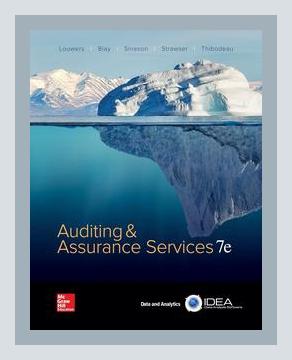Finance and AccountingAuditing
Title: Accounting, Auditing, and Assurance
Author: Rick Williams
Year: 2016
Categories: Auditing
Summary
Introduction
“Accounting, Auditing, and Assurance” by Rick Williams is an exhaustive guide that covers the essentials and advanced concepts in the realm of auditing. The book delves into methodologies, standards, practices, and ethical considerations linked with auditing, and is designed to equip readers—whether students or professionals—with the knowledge and skills necessary to conduct effective audits.
Chapter 1: The Foundations of Auditing
Key Points:
- Definition and Purpose: Auditing is defined as the systematic process of objectively obtaining and evaluating evidence regarding assertions about economic actions and events.
- Historical Context: The evolution of auditing from ancient times to contemporary practices is emphasized, including the introduction of double-entry bookkeeping during the Renaissance as a pivotal moment.
- Types of Audits: Various types of audits are explored, such as financial audits, compliance audits, and operational audits.
Actionables:
- Understand Different Audits: Conduct a comparative analysis to understand the scope and objectives of different types of audits in your organization.
Chapter 2: The Regulatory Environment
Key Points:
- Legal Framework: Discusses the legal framework governing auditing, such as the Sarbanes-Oxley Act in the United States.
- Standard-Setting Bodies: Explains the role of organizations like the PCAOB, AICPA, and IASB in setting auditing standards.
- Compliance: Importance of adhering to regulations to ensure credibility and transparency.
Actionables:
- Stay Current: Regularly review updates from standard-setting bodies to ensure compliance with the latest regulations.
- Compliance Programs: Implement a compliance program within the organization to regularly check adherence to legal requirements.
Chapter 3: Risk Assessment and Planning
Key Points:
- Risk Identification: Processes for identifying risks that could impact the audit.
- Materiality Judgment: Techniques for determining the materiality of various financial statements.
- Audit Planning: Comprehensive audit planning, including client acceptance and retention policies.
Actionables:
- Risk Management Framework: Develop a risk management framework that involves regular risk assessment, documentation, and management.
- Materiality Guidelines: Create internal guidelines to evaluate the materiality of financial information efficiently.
Chapter 4: Internal Controls
Key Points:
- Components of Internal Control: Explores the five components of internal control as outlined by COSO: control environment, risk assessment, control activities, information and communication, and monitoring.
- Importance of Internal Control: Highlights the role of internal controls in preventing fraud and errors.
Actionables:
- Internal Control Assessment: Conduct an annual internal control assessment using the COSO framework.
- Training Programs: Develop training programs for employees to understand and adhere to internal control procedures.
Chapter 5: Gathering Evidence
Key Points:
- Evidence Collection Methods: Discusses methods such as inspection, observation, inquiries, and confirmations.
- Audit Documentation: Importance of maintaining proper audit documentation to support findings and conclusions.
Actionables:
- Audit Checklists: Develop comprehensive checklists for evidence collection tailored to different audit scenarios.
- Documentation Standards: Establish clear policies for maintaining and storing audit documentation.
Chapter 6: Analytical Procedures
Key Points:
- Nature of Analytical Procedures: Use of comparisons and relationships to assess the reasonableness of financial information.
- Types of Analysis: Horizontal and vertical analysis, ratio analysis, and trend analysis.
Actionables:
- Analytical Software: Utilize software tools to aid in conducting and documenting analytical procedures.
- Ongoing Training: Provide ongoing training on analytical procedures to ensure proficiency.
Chapter 7: Fraud Detection
Key Points:
- Fraud Theories: Insight into theories such as the Fraud Triangle, which focuses on pressure, opportunity, and rationalization.
- Red Flags: Identifying red flags or indicators of fraud.
- Investigative Techniques: Techniques for investigating and detecting fraud.
Actionables:
- Fraud Detection Programs: Establish a fraud detection program that includes regular monitoring and checks for red flags.
- Whistleblower Policies: Implement anonymous reporting mechanisms to encourage reporting of fraudulent activities.
Chapter 8: Audit Reporting
Key Points:
- Types of Audit Reports: Exploration of different types of audit reports, such as unqualified, qualified, adverse, and disclaimer of opinion.
- Components of an Audit Report: Essential components and the structure of a standard audit report.
- Communication with Stakeholders: Importance of effective communication with stakeholders to convey findings.
Actionables:
- Report Templates: Create standardized templates for different types of audit reports to ensure consistency.
- Communication Plan: Develop a communication plan outlining how audit findings will be shared with stakeholders.
Chapter 9: Professional Ethics in Auditing
Key Points:
- Ethical Principles: Key principles such as integrity, objectivity, professional competence, confidentiality, and professional behavior.
- Code of Conduct: Importance of adhering to professional codes of conduct as outlined by bodies such as the AICPA.
- Ethical Dilemmas: How to navigate and resolve ethical dilemmas in the auditing profession.
Actionables:
- Ethics Training: Implement mandatory ethics training sessions for audit staff.
- Ethics Committee: Form an ethics committee to oversee and enforce ethical behavior within the organization.
Chapter 10: Technological Advancements in Auditing
Key Points:
- Audit Software: Use of software tools for data analytics and audit management.
- Cybersecurity: Increasing importance of cybersecurity measures in protecting financial information.
- Emerging Technologies: Impact of technologies like blockchain and artificial intelligence on auditing practices.
Actionables:
- Technology Upgradation: Regularly update audit technologies to leverage the latest advancements.
- Cybersecurity Policies: Develop robust cybersecurity policies to safeguard financial information.
Conclusion
Rick Williams’ “Accounting, Auditing, and Assurance” critically examines the field of auditing with detailed explanations and guidance on various facets of the profession. From foundational principles to advanced techniques and ethical considerations, the book offers a comprehensive understanding of the discipline, making it a valuable resource for auditing professionals.
Action Plan for Using the Book:
– Develop a structured learning program based on each chapter.
– Apply practical examples in your organization to better understand theoretical concepts.
– Keep abreast of regulatory updates and technological advancements mentioned in the book.
This summary aims to capture the essence of Williams’ detailed examination of auditing, providing readers with actionable insights and robust knowledge to implement in their professional auditing activities.
